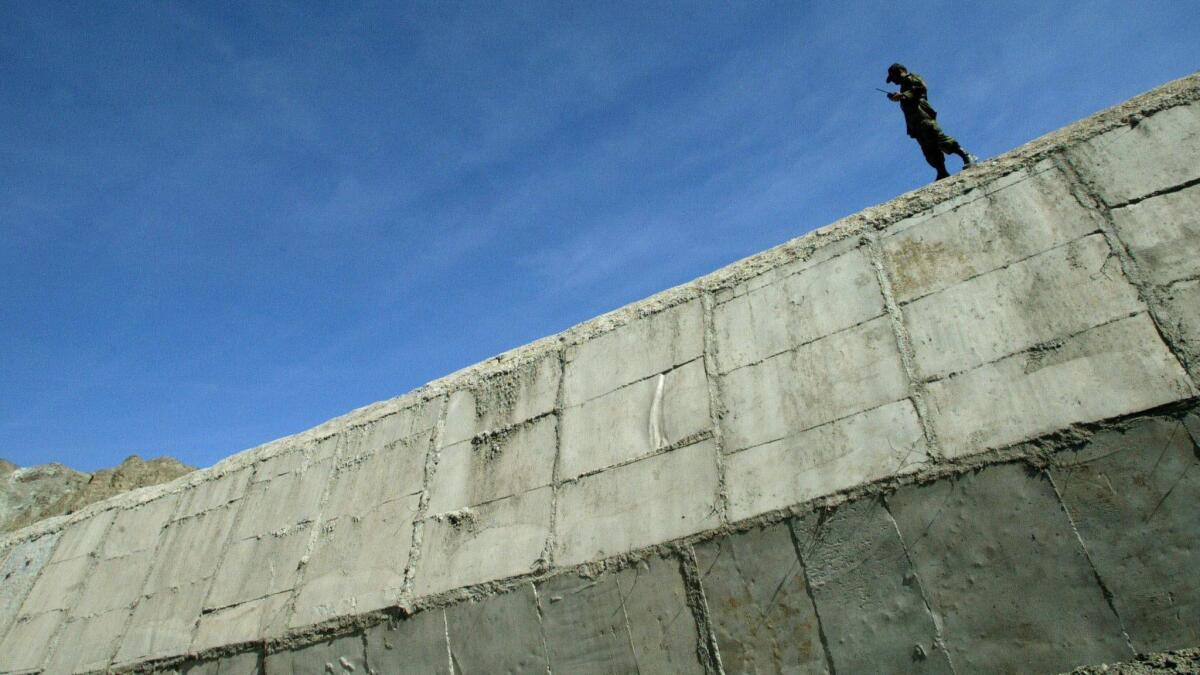Border walls aren’t unheard of, but today they increasingly divide friends, not enemies

Critics of President Trump’s orders to build a wall on the U.S.-Mexico border have called the plan immoral or question the normalcy of building a barrier against a longtime ally with which the U.S. is at peace.
It turns out that Trump’s move is not so unusual. Geographers and experts on borderlands say Trump’s wall is part of a growing trend of nations fencing off their neighbors — even those they call friends.
Barriers for military defense are anomalies now, said Elisabeth Vallet, an adjunct professor of geography at the University of Quebec at Montreal and an expert on international border barriers. “Most of them are between countries at peace. It’s fencing ourselves in rather than keeping an enemy state out.”
There were very few barriers between nations at the end of World War II and just 15 in 1990, said Reece Jones, an associate professor of geography at the University of Hawaii at Manoa and author of “Violent Borders: Refugees and the Right to Move,” which explores how borders are formed and policed. But in the last five years, 25 new walls and fences have gone up between nations, he said.

An uptick in barrier-building occurred after the so-called Arab Spring, the series of antigovernment protests and rebellions that spread across the Middle East in early 2011, according to Vallet’s research. At least 70 border barriers separated nations from their neighbors as of last October, Vallet said.
Some of the latest construction includes Hungary’s erection of a barrier on its border with Serbia and Croatia in 2015. Bulgaria also built a fence along the Turkish border that year and expanded it in 2016 — ironic because after the fall of communism in Bulgaria in 1989, authorities took pains to tear down a wall designed to keep people in.
Construction on a British-financed 13-foot-high barrier in the French port city of Calais, aimed at preventing refugees and migrants from entering Britain, began in September. Norway started building a steel fence — 660 feet long and 11 feet high — at its arctic border with Russia.
And just this month, Lithuania, Turkey and Myanmar announced plans to construct barriers on their borders.
All of this construction raises walls — and some fundamental questions:

What’s driving all this construction?
Though most barriers — concrete walls, barbed-wire fences and sand berms — were constructed to deter trafficking and terrorists, newer barriers aim to stop migrants.
“It’s more of an effort to control migration than for peacekeeping,” Vallet said. “Democracies are picking up on the idea of keeping people out.”
Typically, the goal is to prevent people from poorer nations of the global South from entering the more wealthy and industrialized nations of the North, experts said.
“What would be unusual would be to have a wall between countries that are equivalent economically,” said Kenneth D. Madsen, associate professor in geography at Ohio State University at Newark. “Today, the walls are really between countries that have economic discrepancies.”
Barriers also are being used to send a message, not only to outsiders but to a national audience, border experts said.
During his election campaign, Trump said the U.S.-Mexico wall would be built to keep out Mexicans he described as “criminals, drug dealers, rapists.”
“What politicians want is to communicate to the electorate that something is being done,” Madsen said. “It’s not about stopping people; it’s about communicating.”
Jones, the academic from Hawaii, noted that “a wall symbolizes action. It’s a powerful symbol of action to counter the things that people are afraid of.”
Vallet said Trump was using the theory of the “clash of civilizations” — that in the post-Cold War world, the main course of conflict will be over cultural and religious identity.
“It’s the fear of the other,” Vallet said. “The other being somebody you don’t know, somebody you fear … the fence being the solution.”

An Iranian soldier stands guard in 2003 at a wall built to prevent drug trafficking in the Mirjaveh point where the borders of Iran, Afghanistan and Pakistan meet.
But do barriers actually work?
“What scholars have found is that walls and barriers seem to have very little impact,” Jones said.
Countries are “investing a lot of money on something you can go over, under or around,” Vallet said.
Migrants are often forced to find alternative means of crossing a border, and the new routes are often more dangerous, even deadly, Jones said.
For example, in the 2000s, more than 2,000 migrants a year died trying to cross into the U.S. from Mexico, Jones said. In other parts of the world, thousands of migrants have perished trekking through deserts or on shoddy boats trying to cross the Mediterranean to Europe.
What are the arguments for building barriers?
Countries facing tension from or in conflict with neighbors say their efforts to physically insulate themselves are justified.
Israel, for example, has built barriers in the West Bank and along its boundaries with Egypt, Lebanon and the Gaza Strip. Saudi Arabia has fenced itself off from Yemen and the United Arab Emirates and is working on a giant wall and ditch along its border with Iraq.
India hopes to complete a 2,500-mile barbed-wire barrier along its border with Bangladesh this year. Last year, fearing Moscow’s possible move toward expansionism, the Baltic state of Estonia approved the building of a fence on its border with Russia.
ALSO
For Mexico, Trump’s retreat on NAFTA is ‘like being drenched by a pail of cold water’
Read Mexican President Enrique Peña Nieto’s fiery speech about Trump’s order to build a wall
More to Read
Sign up for Essential California
The most important California stories and recommendations in your inbox every morning.
You may occasionally receive promotional content from the Los Angeles Times.











